The sun and the moon are the most conspicuous objects in the sky. In this section, we will discuss the orbital properties of our moon. Hopefully, you will come to appreciate the role our moon plays in shaping our traditions, our culture, and even the role it plays in our very existence.
As the moon orbits the earth, it does so in a very unusual way known as synchronous rotation (also known as a tidal lock). This means it always keeps one side facing the earth. Thus, we always see just one side of the moon and never see the back side (also known as the far side). There is really no permanent "dark side of the moon" as proclaimed by Pink Floyd since the back side gets just as much sunlight in a synodic month as the side facing us. Why the moon exhibits this unusual orbital behavior will be discussed in the next unit.

Sorry, I can not find the author of this excellent animation for
proper credit
As you watch the animation, there are several items to take note of. For now, just realize that only one side of the moon is directed toward the earth.
Most students initially rationalize that the moon does not rotate (especially after viewing the animation above), but why would they call it synchronous rotation if it didn't rotate? The moon does rotate on its axis, but the rotation rate is exactly matched to the moon's rate of revolution.
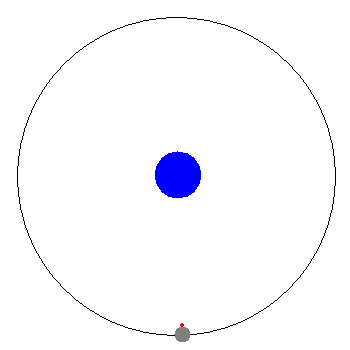
The moon rotates on its axis (animation)
As you watch this animation, the revolution is unmistakable but what about rotation? Just concentrate on the moon itself and you will see that it is spinning on its axis.
In the first unit, we discussed the major phases of the moon - New, 1st quarter, Full, and 3rd quarter. This cycle repeats every 29˝ days and is known as the synodic month. This cycle was the reason our early calendar contained months (covered in the last unit). The Jewish calendar still takes the lunar cycle into account, and the Islamic calendar relies solely on the lunar cycle. We saw that the phases come from the angular relationships between the sun, moon, and earth ... as the moon reflects sunlight in our direction. We can now go a bit further and discuss the minor phases as well.
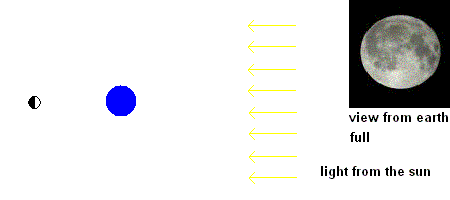
All the lunar phases are covered in this animation.
During the first half of the lunar cycle, the moon is waxing. This means that as the nights progress, more of the moon is being illuminated (as seen from earth) ... until it becomes full. After that, the moon becomes less illuminated as it approaches new. The moon is said to be waning during this time. Two new phases are introduced in this animation - crescent moon and gibbous moon. The complete cycle, therefore, becomes:
New
waxing crescent
1st quarter
waxing gibbous
Full
waning gibbous
3rd quarter
waning crescent
What is the current moon phase? Click here to find out.
Can you identify the moon phase in the image at the top of the screen? Click here for the answer. You better know these things for the test.
Can you also see why the back side of the moon (far side) should not be called the dark side (all apologies to Pink Floyd and Darth Vader)? Hint: Where is the sun shining when the moon is new?
A clever person who knows the current phase of the moon can also tell you where to find it (provided it is in the local horizon). This is because the moon phase you see is directly related to the moon's angle with the sun. If you know where the sun is, you can also find the moon. Let me explain.
First, don't even try to find the new moon (maybe it should be called no moon). The new moon is invisible because it is lost in the glare of the sun, but that is the key to locating it. Point to the sun, and you've found the new moon.
When does a new moon rise? Answer: At sunrise (in the east). When is a new moon on the meridian? Answer: Around noon (remember clocks are not exactly in sync with the sun).
The full moon is always found opposite of the sun. Just point to the sun ... the full moon is 180 degrees away.
When does a full moon rise? Answer: When the sun is setting. Where is the full moon at midnight? Answer: Near the meridian ... because the sun is on the meridian around noon. The sun is rising ... where is the full moon? Answer: The full moon is just setting (in the west).
The 1st quarter moon is found about 90 degrees east of the sun (or the sun is about 90 degrees west of the 1st quarter moon). The 3rd quarter moon is found about 90 degrees west of the sun (or the sun is about 90 degrees east of the 3rd quarter moon).
Where is the 3rd quarter moon at noon? Answer: If the sun is near the meridian, the 3rd quarter moon must be 90 degrees west of it so you will find it on the western horizon (just setting). When will you find the 1st quarter moon on the meridian? Answer: If the 1st quarter moon is on the meridian, the sun must be 90 degrees west of it ... which places it on the western horizon. That means it is sunset.
Most students don't hesitate to give an answer - 29˝days ... wrong! The cycle of phases does take 29˝ days, but a synodic month is not the same as sidereal month. It takes 27⅓ days for the moon to orbit the earth ( a sidereal month). The animation below should convince you of this.
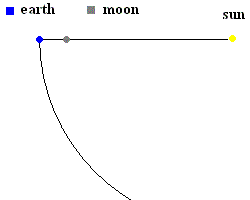
The sidereal month vs. the synodic month (animation)
Sure it does ... sort of! Actually both the moon and the earth orbit around a common point called the barycenter. The barycenter of the earth-moon system actually lies inside the earth about 1000 miles below the surface of the earth (in the direction of the moon). I guess you can say that the moon orbits the earth.
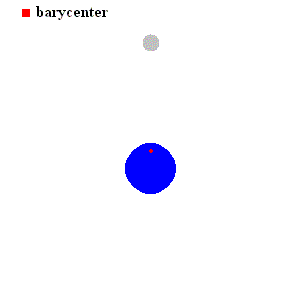
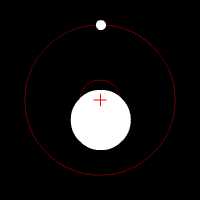
The barycenter of the earth-moon system (animation)

Courtesy John Walker
The two images of the full moon (in the picture above) are designed to demonstrate a simple fact - the moon sometimes appears bigger than at other times. Of course the moon can not physically change its size, but it can appear larger because it is closer. Kepler's laws (which were originally written to describe the orbital properties of the planets as they revolved around the sun) also pertain to the orbit of the moon. That is, the moon orbits in an elliptical orbit. When the moon is closest to the earth (called perigee), it appears slightly larger than when it is seen at apogee (farthest point from the earth). The picture above shows the moon at these two extremes. In fact, when a full moon occurs when it at its perigee, it is called a "supermoon" (image of the moon on the left in the picture above). As you may recall from our discussion of gravity in unit 2, when there is a supermoon, tides are at their most extreme.
Because the moon also speeds up and slows down as it orbits the earth, an interesting phenomena results. The moon appears to "wobble" slightly ... allowing us to see "around the corners" just a bit. These "librations" actually allows us to observe 59% of the lunar surface from the earth. Both effects can be observed in the animation below:

Can you tell the moon phase at perigee? (animation)
Biologists have linked several biorhythm cycles to the moon cycle. This may be the result of tidal interactions which the moon provides. Psychologists have done numerous studies to study the effect the moon has on human behavior (with mixed results). The term lunatic comes from the idea that people get a little crazy during a full moon. I'm not a biologist or a psychologist, so I will not comment on the validity of these claims. I can assure you that the moon has played a very crucial role in the development of life on the earth. How?
Due to tidal interactions with the moon, the earth's rotation
rate has slowed down considerably. We would have a much shorter day if we
never had the moon. This surely would have effected the way life would have
developed on a moonless earth.
Computer models have shown that if we did not have the moon, our orbital tilt would vary much more than the small variations we experience now. Imagine a world where the axis tilt is allowed to vary from 0 degrees to 90 degrees over time. Life as we know it would be impossible because no environment would be stable.
How often have you gone outside ... only to see a huge moon hovering over the horizon? You may have even exclaimed "Wow, the moon really looks big tonight". The discussion above may now convince you that the moon was probably near its perigee, and it really appears big for that reason. But you could have also fallen for an optical illusion in the sky, known as the moon illusion.
Below are some classic illusions. See if you are fooled by any of them.
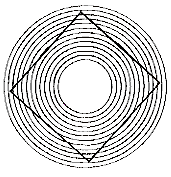 Are the lines straight? |
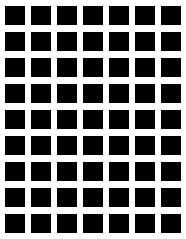 Do you see grey dots in the corners? |
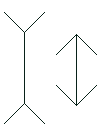 Which line segment is the longest? |
The "moon illusion" tells us that when we observe the moon near the horizon, it appears bigger. If you were to observe the same moon a few hours later, you may swear that it has gotten smaller. In fact, as the night progresses and the moon moves closer to the meridian, it actually appears bigger ... not smaller, because it has gotten closer to us (the animation below should convince you of that). Why does this happen? There are thousands of web pages claiming to have the answer. The most common answer is a result of the way we observe the moon. When it is near the horizon, we see the moon against familiar background of trees, buildings, mountains, etc. This contrast fools our brains into thinking that the moon is much bigger. As the night progresses, the moon moves away from the horizon and we lose the background contrast ... and we think the moon shrank. I don't have the answer ... try it for yourself the next time you watch a full moon rise.
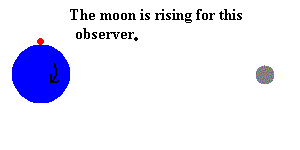
The moon should appear bigger as it moves from the horizon! (animation is not to scale)
If you have ever looked carefully at the moon when it is a thin crescent, you will be able to make out an faint outline of the entire moon. This phenomena has been observed through the ages, but wasn't explained until Leonardo Da Vinci (Mona Lisa fame) gave his explanation.
|
|
With permission: Credit: Dennis Mammana. |
Basically earthshine is second-hand sunlight ... light which is reflected off the earth and then onto the moon. The diagram below should clear up this mystery.
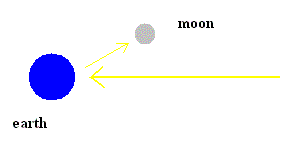
The moon has inspired countless songs and poems ... as well as the not-so romantic art of "mooning". Some notable entries are:
Moon River, Silvery Moon, Shine on Harvest Moon, Blue Moon, Fly Me to the Moon, Dark Side of the Moon, Moon Shadow, Man on the Moon, etc. Click here for more. Frank Zappa even named his daughter "Moon Unit".
Without the moon, Michael Jackson would never have done a "moon walk".
Moon shiners would all be sober.
The term "blue moon" is often used to convey an event which happens infrequently .. as in "once in a blue moon". Where did this phrase originate? Although quite unscientific, the general meaning of "blue moon" is understood to be a month which contains 2 full moons. That doesn't happen too often ... only once in a blue moon. Actually just about once every 33 months you get a "blue moon" ... so it really isn't all that rare. A "black moon" is when you have two new moons within one month ... again ... quite rare. If you ask me (but I don't make the rules), a month without a full moon should be the example. This is really a rare event, happening in February of 1866, 1885, 1915, 1934, 1961, and 1999. You can get data here. There will be no February full moon in 2018, 2037, 2067, and 2094.
Ok, I admit this is stretching things a bit but go to any search engine on the internet and enter these two phrases - honeymoon and "history of beer". You be the judge.
The moon gave our country a perfect goal in the 1960's as we were routinely beaten to the punch by the Russians in the "race for space". The moon landings (1969-1972) led to countless by-products in technology ... including the computer you are reading this on now. The moon still offers a perfect "stepping stone" in an effort to colonize space.
My first view of the moon through a telescope (at age 6) inspired me to study astronomy, ... a passion I've had ever since.
Earth's Second Moon
OK, it isn't big and it won't last too long but on occasion, an asteroid can be caught in a spaghetti like orbit and become a temporary moon of the Earth. The latest entry is 2020 CD3! Like the one discovered in 2006, it was only seen with powerful telescopes and there may be several undiscovered moons we don't even know about. You will certainly know about it if one of these things hits the earth!
ŠJim Mihal 2004, 2014, 2020 - all rights reserved
Answer: Waxing Gibbous Click here to go back to the question.